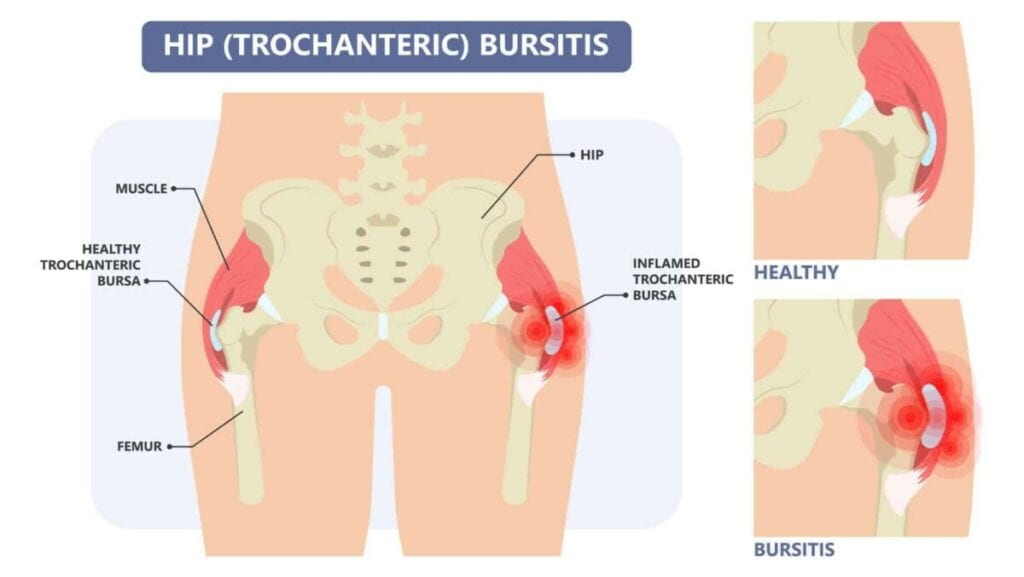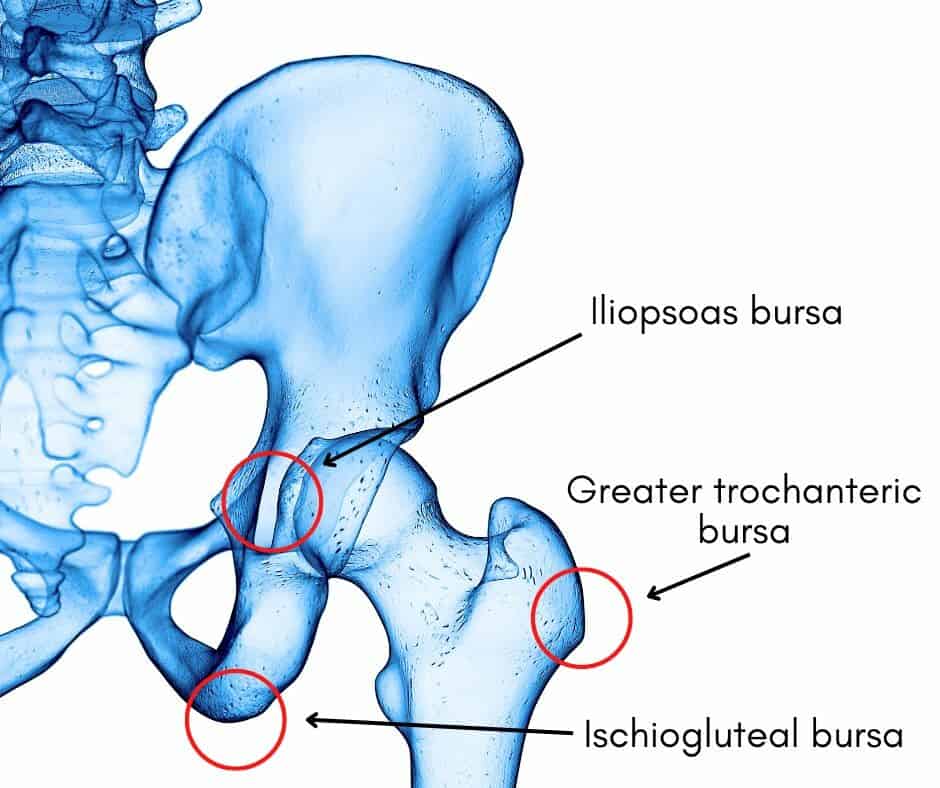Causes of Outer Hip Pain?
- Best Asics Shoes for Flat Feet - October 25, 2024
- Best Running Shoes for Flat Feet - October 22, 2024
- Posterior Tibial Tendonitis - October 21, 2024
Hip Bursitis vs Tendonitis
There are several similar symptoms between hip bursitis and tendonitis. Common symptoms of both include pain on the outside of the hip, and pain when crossing legs or lying on your side. Activities such as walking, running or climbing stairs can be painful for both conditions.
A difference is the quality of the pain; bursitis is often described as hot and can look and feel swollen. Often, it is more painful to touch than tendonitis.
Hip bursitis most often affects the greater trochanteric bursa on the outside of the hip. This bursa sits between the bony prominence of the femur, thigh bone, and gluteus maximus muscle. The attachment of the gluteal muscles to the femur at this location is via tendons.
One of the key differences between these conditions is that Gluteal tendonitis symptoms can improve with exercise whereas bursitis will worsen. The best way to get a diagnosis is to see an experienced physical therapist. You can click the link to read more about Hip Bursitis Symptoms and Diagnosis.

Hip Bursitis vs Arthritis
Hip arthritis has more unique symptoms compared to hip bursitis than other pathologies like tendonitis. Arthritis is a painful condition but is usually accompanied by stiffness and a reduced range of movement of the joint, which is not caused by bursitis.
Arthritis and bursitis, however, both develop gradually over time in most cases and they can be triggered or exacerbated by an acute event. Bursitis will generally get worse with activity, while arthritis can feel more painful and stiff at the start, and usually, the joint feels like it “warms up” over the first 20-30 minutes of exercise.
Both conditions will feel pain with impact activity such as hopping or running and have similar specific positions that aggravate pain. The positions that aggravate these conditions are internal rotation, adduction and flexion of the hip.
A difference that will be seen on assessment is that bursitis may be painful with these positions, but the range of movement will not be restricted whereas an arthritic hip will be restricted in motion.
What is the Difference Between Hip Bursitis and Labral Tear?
A gluteal hip bursitis and labral tear can both cause pain in the hip area, but the difference between these two pathologies is the location of pain and some specific symptoms. A hip labral tear will usually present with pain that wraps around the outside of the hip, often in a “C” shape made by putting your index finger and thumb around your hip.
In contrast, hip bursitis pain is usually a patch on or just behind the bony prominence of the femur at the outside of the hip, rarely felt at the front. Another bursitis at the hip is at the hip flexor and this will only be felt at the front of the hip, rarely anywhere else.
A labral tear can also produce sounds when the hip moves, like a click or a sensation of a clunk, both absent with bursitis. We have explained Hip Labral Tears in more detail.

What Causes Bursitis After Hip Replacement?
Following hip replacement, common complications involve the muscles around the hip. This is because these muscles are cut through to access the hip for the surgery. As these muscles recover and repair, they can feel weak and tight, putting more pressure on the bursae around the hip.
Typically after hip replacement surgery, you will receive physical therapy, and your therapist will be aware of this likely complication.
Recovery will include specific muscle strengthening exercises, pain relief with ice packs, activity modification, and anti-inflammatory medications. In more severe or persistent cases, cortisone injections may be offered to help reduce pain.
Can Bursitis Cause IT Band Pain?
Yes. Bursitis can cause IT band pain. The gluteal muscles function to perform movements at the hip and provide stability to the pelvis. The IT band also have functions to assist hip movements and pelvis stability. Gluteal muscle weakness is a common contributing factor or cause of bursitis.
Gluteal weakness can also cause the IT band and the TFL (tensor fascia lata muscle) at the top of the band to work more and tighten, causing pain. You can click the link to read more about Iliotibial Band Syndrome.
What is the relationship between sciatica and hip bursitis?
Hip bursitis can be a mistaken diagnosis for sciatica pain. A common area of pain with sciatica is in the buttocks, where hip bursitis that affects the ischiogluteal bursa is also felt. The ischiogluteal bursa sits over the seat bone to protect the gluteus maximus muscle, and the sciatic nerve is the main nerve from the lower back that supplies the back and outside of the leg.
Both conditions can be aggravated or developed after sitting for long periods of time and relieved by standing, so differentiating the diagnosis can be difficult. In a clinical assessment, differentiation tests include palpation of the area, neural tension positions, as well as hip and lower back movements.
In our experience, Sciatica is more likely to provide continuous pain throughout the day and often wakes patients at night whereas bursitis is only painful at night when you apply direct pressure to the area.

Can Hip Bursitis Cause Back Pain?
In our experience, yes, it is possible for hip bursitis to cause back pain. The causes of hip bursitis can also contribute to the development of back pain.
Weakness of the gluteal muscle and the resultant poor stability and biomechanics of the pelvis can cause the muscle in the back to work more. This can result in fatigue and pain in these muscles.
Alternatively, compromises to a patient’s gait and standing position due to the pain caused by Hip bursitis can lead to an overload of the lower back and result in back pain.
Related Article: Hip Pain Diagram
_______________________________________
We are specialists in Physiotherapy, with our clinic in Fulham, South West London.
We offer Online Appointments for £60 and Face-to-Face appointments for £85 in our clinics.
